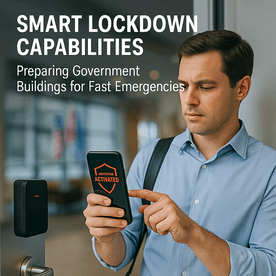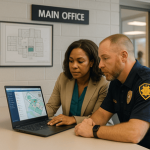
In today’s world, emergencies don’t give you time to think—they demand action. Whether it’s an active threat, a medical crisis, or a suspicious intruder, government buildings need the ability to secure quickly and strategically. That’s where smart lockdown technology comes in.
If you manage a city hall, courthouse, public utility, or any multi-use municipal facility, you’re likely asking:
“How can we lock down the building fast—without putting everyone at risk or causing confusion?”
This article walks you through what smart lockdown capabilities look like, why they’re essential for public sector buildings, and how SSP helps cities implement systems that are fast, flexible, and fail-safe.
k
k
What Is Smart Lockdown?
A smart lockdown system allows authorized staff to trigger automated, zone-based building lockdowns—from a mobile app, desktop dashboard, wall-mounted button, or even through integrated emergency alerts.
Unlike older “all-or-nothing” lockdowns (which simply locked every door), modern systems give you options:
- Lock only certain zones (e.g., public lobby, council chambers, staff-only floors)
- Allow emergency exits and first responder access
- Trigger alerts via intercom, text, or integrated PA systems
- Connect to surveillance and verify what’s happening in real time
The key word is smart—meaning controlled, responsive, and situational.
k
k
Why Government Buildings Need Smart Lockdown Capabilities
1. Public Accessibility + Security = Complexity
City buildings must remain open and welcoming to the public—while also keeping staff, records, and infrastructure safe. This balancing act makes fast, zone-specific lockdowns critical.
Example: If a disturbance occurs in the public records office, the building shouldn't shut down entirely. Locking access to that zone while securing others can protect staff and defuse the situation faster.
k
k
2. Multi-Use Facilities Require Targeted Lockdowns
Many municipal buildings serve multiple functions: a police substation on the first floor, administrative offices above, and a community event space downstairs.
A single access control system must:
- Divide the facility into security zones
- Offer different lockdown protocols for each
- Maintain public egress routes
SSP designs systems that allow custom lockdown levels per zone, so your team doesn’t need to panic and shut everything down at once.
k
k
3. Integrated Alerts Speed Up Response Time
Locking doors is only part of the equation. A proper smart lockdown triggers communication tools as well:
- Pre-recorded voice alerts through speakers
- Text or push notifications to staff
- Notifications sent to police, fire, or emergency response partners
- Auto-activated camera feeds in affected areas
When every second counts, a fully integrated system saves lives and reduces liability.
k
k
4. Compliance and Readiness
Municipalities are under increasing pressure to meet safety standards—especially in public schools, courtrooms, and critical infrastructure buildings. Smart lockdown systems support:
- Drill readiness
- Audit logs for compliance reporting
- Integration with panic buttons or duress stations
SSP works with local agencies to ensure all lockdown systems meet local, state, and federal compliance, including CJIS, NDAA, and other critical standards.
k
k
What Does a Smart Lockdown System Include?
Here’s what a typical SSP smart lockdown implementation for a government facility might include:
| Feature | Purpose |
|---|---|
| Zone-based Access Control | Lock or unlock targeted sections of a building |
| Mobile & Desktop Trigger Points | Secure remotely or from inside the building |
| Integrated Emergency Alerts | Notify staff, first responders, or the public |
| Camera + Door Control Integration | Visual verification and door override |
| Audit Logs & Reports | Document every action for compliance and review |
Every building is different. That’s why we tailor each system based on usage, staffing, layout, and risk level.
k
k
Real-World Scenario: Locking Down Without Locking Out
Imagine this:
A disruptive individual enters a city permit office and refuses to leave. Staff presses a duress button, which:
- Locks entry to the affected area
- Alerts the building security officer
- Sends a silent message to local police
- Opens live surveillance feeds to the command center
- Keeps the rest of the facility operational
No panic. No chaos. Just smart, coordinated response.
l
l
Why SSP?
We specialize in access control and emergency response solutions specifically designed for the public sector. That means:
- We understand how to secure city buildings without interfering with daily operations
- We work within municipal budgets and procurement processes
- We design for compliance from day one
- We help your team build clear policies around when and how to activate lockdown procedures
Our systems are built to protect not just your buildings—but your people, your processes, and your peace of mind.
k
k
Ready to Build Smart Lockdown Into Your Access Strategy?
See how SSP helps government agencies protect their people and infrastructure.
Contact us today to schedule a consultation or security assessment.


